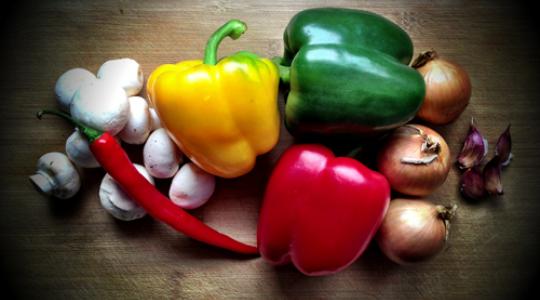
PLANT-BASED PRACTICE: A decent knife and a few basic kitchen utensils are all you need to create tasty, health-promoting meals at home, that also help to control weight. Get familiar with cooking without oil, which takes no extra skill, just swap a liquid on the stovetop and substitute bananas, flax meal or tofu in baking.
In our culture of eating meals out and grabbing fast food, many of us have never been tutored in basic cooking skills, making even simple recipes and meal preparation daunting, let alone adopting a plant-based diet. Creating delectable meals efficiency demands familiarity with utensils and devices, so here we’ll tackle those basics so you can become confident and creative in the kitchen! This is really the basics, and all that you really need to succeed.
Knives
You really don’t need a set of expensive chef’s knives, or a drawer full of fancy gadgets to be efficient in the kitchen. You only need a couple of knives: a large (10”) chef’s knife and a small paring knife – a 6-7” utility knife will do, along with a sturdy cutting board of any kind.
Here are two great video tutorials on how to use them both:
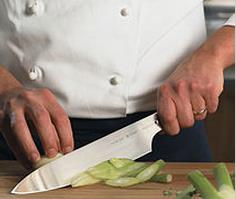
Measuring
Full Disclosure – I don’t measure much, at least in the seasoning department. Measuring is most important for the liquid-to-dry ingredient ratio, particularly for cooking grains, (1 cup brown rice to 2 cups water), and for baking, (which I don’t do much of). As you feel comfortable, use the measurements of the spices and flavorings you see in basic recipes as guidelines, emancipating yourself from measuring spoons – try using your instincts and estimation. Having said that, a few basic measuring receptacles are crucial for success in the kitchen
Measuring Cups
Dry ingredients are meant to be filled right up to the top and then leveled off with a straight edge like a knife. Liquid measuring cups have a pour spout and are made with lined gradations on the side of the cup (1/4 cup, 1/2 cup, 6 oz, etc.) to be filled to, rather than being filled right up to the top. So that’s the difference. How important this difference is depends on how sensitive the recipe is to the liquid-to-dry ratio.
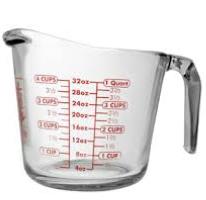
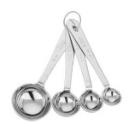
Cooking
Steaming – Of all cooking methods, steaming vegetables preserves most nutrients the best, along with texture and color. A basic steamer or a double boiler is all you need to prepare the most important part of the meal! 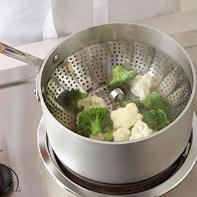
Here’s a short video tutorial on How to Steam Vegetables.
Stir Frying and Sautéing – The difference between stir-frying and sautéing is the heat. Stir-frying is done over high heat, stirring continuously, which retains crispness and color. Sautéing is over a medium, gentler heat to simmer and blend flavors. Both work fine, and both can be easily done without using any added oil. Fat (oil and butter) adds a richer mouth-feel and moisture. Your mouth gets used to the satisfying tastes of food without that fat-feel, and broths or other seasonings add flavor. Water, or vegetable broth, works just fine!
Start a heated pan, medium to high with a splash of liquid in it, add hard veggies like onions, garlic, celery or carrots first, then softer ones as you go, making sure to add another splash to prevent sticking – that’s all there is to it! A key to success is lowering the heat to keep from burning or blackening before all the liquid evaporates – it just takes a bit of experience, so get in that kitchen and try it!
Baking
Easy Water-Sauteing Instructions
Salad Dressings
Look for oil-free dressings in the grocerystory. There are more to choose from nowadays, and the more we buy them, the more variety we will see. Consider making your own at home. Here are some oil-free SD dressing recipes, and here are some substitues for oil in salad dressings for revamping your own favorites:
Appliances
Blender – An expensive, high-powered one is not necessary, but can be useful to grind up seeds and grains, instead of buying flours and meals, which lose nutrient value quickly. The problem  with blending your food is that it can be easily overused. Humans are meant to chew their food, which exercises facial muscles and stimulates digestive enzymes in the mouth to begin breaking down carbohydrates. So don’t use a blender to replace chewing through your meals, but boy, is it useful to make your own sauces, dressings, frozen fruit desserts, and smoothies! Another caution – it is easy to consume more calories by drinking them than eating them, as our bodies still crave a similar volume of food.
with blending your food is that it can be easily overused. Humans are meant to chew their food, which exercises facial muscles and stimulates digestive enzymes in the mouth to begin breaking down carbohydrates. So don’t use a blender to replace chewing through your meals, but boy, is it useful to make your own sauces, dressings, frozen fruit desserts, and smoothies! Another caution – it is easy to consume more calories by drinking them than eating them, as our bodies still crave a similar volume of food.
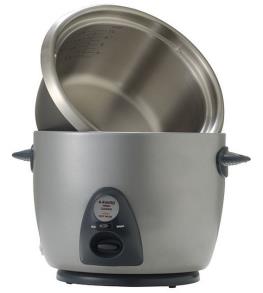
Rice Cooker – A rice cooker is a fairly inexpensive time saver, ($15 on up, averaging $40-$50), but totally not necessary. I find it very easy to cook up a batch of brown rice on the stove and was resistant to change, but after inheriting one from my son’s dorm room, found a new appreciation. You can use it to prepare meals ahead by adding brown rice or other grains, with vegetables and flavorings, into the pot and set it to be ready at dinner time.
Food Processor – This appliance uses a blade to chop things up and/or blend them into spreads and doesn’t require liquid to do it, like a blender. This is handy for making hummus or pesto, chopping onions or nuts finely. You can find small or large capacities, and actually, a small one may be more efficient at some tasks like chopping seeds and nuts. As with a blender, this is not a necessity. You may also do just fine with one or the other. Consider that each of these take up precious counter space. 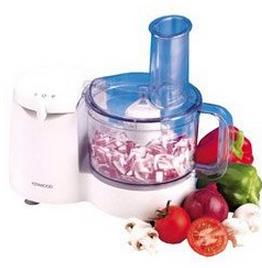
Pressure Cooker – A pressure cooker can reduce cooking times up to 75%, for beans for instance, or half the time on average, for brown rice for instance. Steam and pressure work together to cook foods faster. It gets really hot in there, hotter than boiling on the stove, and there are safeguards to keep from opening the lid while under pressure. It’s important to follow the manufacturer’s directions. I absolutely love this device for cooking beans, making soups and stews, and cooking grains at the last minute. I have an old-fashioned “jiggle-top” that I must have replaced the rubber ring and plug a zillion times over decades, and it keeps working beautifully.
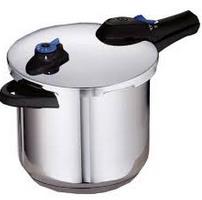
Cleaning Up
This part can be overwhelming and a deterrent in itself to preparing food.
Free Bonus: Mentally organizing clean-up while you cook is a great brain exercise for cognitive fitness and protection!
PLANT-BASED PRACTICE: A decent knife and a few basic kitchen utensils are all you need to create tasty, health-promoting meals at home, that also help to control weight. Get familiar with cooking without oil, which takes no extra skill, just swap a liquid on the stovetop and substitute bananas, flax meal or tofu in baking.
In our culture of eating meals out and grabbing fast food, many of us have never been tutored in basic cooking skills, making even simple recipes and meal preparation daunting, let alone adopting a plant-based diet. Creating delectable meals efficiency demands familiarity with utensils and devices, so here we’ll tackle those basics so you can become confident and creative in the kitchen! This is really the basics, and all that you really need to succeed.